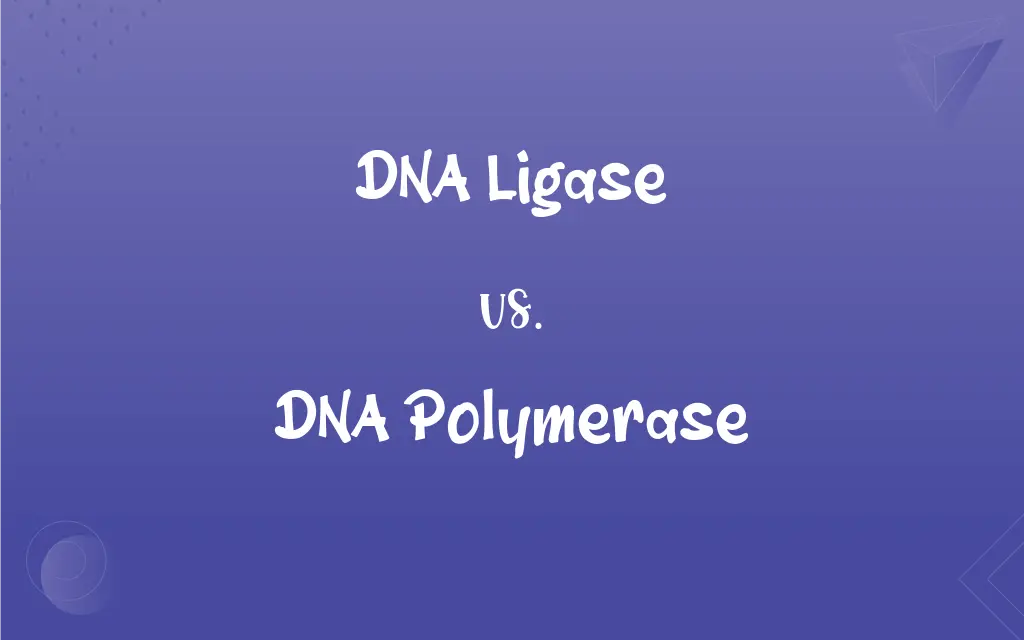DNA Ligase vs. DNA Polymerase: What's the Difference?
Edited by Janet White || By Harlon Moss || Published on December 3, 2023
DNA Ligase is an enzyme that joins DNA fragments; DNA Polymerase is an enzyme that synthesizes new DNA strands.

Key Differences
DNA Ligase is an enzyme crucial for DNA repair and replication, as it joins together fragments of DNA. It acts like a molecular glue, sealing breaks or nicks in the DNA strand. In DNA replication, DNA ligase is responsible for joining the Okazaki fragments on the lagging strand. DNA Polymerase, on the other hand, is responsible for synthesizing new DNA strands by adding nucleotides. It plays a key role during DNA replication, where it reads the existing DNA strand and creates a complementary new strand.
DNA Ligase is used in molecular biology and genetic engineering to splice together DNA fragments in recombinant DNA technology. It's essential in processes like cloning and genetic modification. DNA Polymerase not only synthesizes new DNA strands but also possesses proofreading ability to ensure accuracy in DNA replication. It corrects errors by removing mismatched nucleotides and replacing them with the correct ones.
In terms of their functionality, DNA Ligase is more about connecting or repairing existing DNA strands. It's crucial for maintaining the integrity of the genetic code by fixing breaks in the DNA. DNA Polymerase, in contrast, is about creation and accuracy. It ensures that the genetic information is accurately replicated for cell division, playing a direct role in genetic inheritance.
DNA Ligase operates by catalyzing the formation of a phosphodiester bond between the 3' hydroxyl end of one nucleotide and the 5' phosphate end of another. This action is vital in linking DNA fragments during replication and repair. DNA Polymerase operates by adding nucleotides to the 3' end of a growing DNA strand, requiring a primer to initiate synthesis. It is fundamental in replicating the cell's genetic material during cell division.
DNA Ligase and DNA Polymerase are both essential enzymes in DNA metabolism, but they serve different functions. DNA Ligase is central to connecting DNA fragments, while DNA Polymerase is crucial in synthesizing new DNA strands, ensuring the faithful transmission of genetic information.
ADVERTISEMENT
Comparison Chart
Function
Joins DNA fragments.
Synthesizes new DNA strands.
Role in DNA Replication
Seals Okazaki fragments on lagging strand.
Reads template strand to create complementary strand.
Use in Genetic Engineering
Essential for DNA splicing and recombination.
Key in DNA replication and PCR amplification.
Mechanism
Catalyzes formation of phosphodiester bonds.
Adds nucleotides to the 3' end of a growing strand.
Proofreading Ability
None.
Has proofreading and error-correcting capabilities.
ADVERTISEMENT
DNA Ligase and DNA Polymerase Definitions
DNA Ligase
Enzyme that Seals DNA Breaks.
DNA ligase repairs nicks in the DNA during replication.
DNA Polymerase
Requires a Primer to Function.
DNA polymerase initiates synthesis from an existing primer.
DNA Ligase
Maintains Genetic Integrity.
DNA ligase ensures continuity and integrity of the DNA strand.
DNA Polymerase
Synthesizes New DNA Strands.
DNA polymerase creates a new DNA strand complementary to the template strand.
DNA Ligase
Facilitates DNA Recombination.
DNA ligase is used to join foreign DNA into plasmids in cloning.
DNA Polymerase
Proofreads and Corrects Errors.
DNA polymerase's proofreading ability maintains genetic fidelity.
DNA Ligase
Connects Okazaki Fragments.
DNA ligase links Okazaki fragments on the lagging strand during replication.
DNA Polymerase
Key in DNA Replication.
DNA polymerase is essential for copying genetic information.
DNA Ligase
Critical in Genetic Engineering.
DNA ligase's ability to splice DNA is key in genetic modification.
DNA Polymerase
Central in PCR Techniques.
DNA polymerase is used to amplify DNA segments in PCR.
FAQs
What does DNA polymerase do?
Synthesizes new DNA strands.
What is DNA ligase?
Enzyme that joins DNA fragments.
How does DNA polymerase function?
Adds nucleotides to form DNA strands.
Where is DNA ligase used?
In DNA repair and replication.
Does DNA ligase have proofreading ability?
No, that's specific to DNA polymerase.
Can DNA ligase join mismatched DNA ends?
It joins complementary DNA ends.
How does DNA ligase affect replication?
Seals Okazaki fragments on lagging strand.
Is DNA polymerase essential for cell division?
Yes, for replicating DNA.
Is DNA ligase involved in genetic engineering?
Yes, in splicing DNA fragments.
What role does DNA polymerase play in PCR?
Amplifies DNA segments.
Can DNA polymerase fix errors?
Yes, it has error-correcting capabilities.
What's unique about DNA ligase's mechanism?
Catalyzes phosphodiester bond formation.
How is DNA polymerase used in genetic studies?
For DNA sequencing and analysis.
Does DNA polymerase need a primer?
Yes, to initiate synthesis.
How does DNA polymerase ensure accuracy?
Through its proofreading function.
Is DNA ligase active in all cells?
Yes, it's vital for DNA integrity.
Does DNA ligase have any role outside replication?
Involved in DNA repair processes.
What's the speed of DNA polymerase activity?
Very fast, adding thousands of nucleotides per minute.
Can DNA ligase function independently?
Requires DNA fragments with compatible ends.
What's the temperature tolerance of DNA polymerase?
Varies, but some are heat-stable for PCR.
About Author
Written by
Harlon MossHarlon is a seasoned quality moderator and accomplished content writer for Difference Wiki. An alumnus of the prestigious University of California, he earned his degree in Computer Science. Leveraging his academic background, Harlon brings a meticulous and informed perspective to his work, ensuring content accuracy and excellence.
Edited by
Janet WhiteJanet White has been an esteemed writer and blogger for Difference Wiki. Holding a Master's degree in Science and Medical Journalism from the prestigious Boston University, she has consistently demonstrated her expertise and passion for her field. When she's not immersed in her work, Janet relishes her time exercising, delving into a good book, and cherishing moments with friends and family.






































































